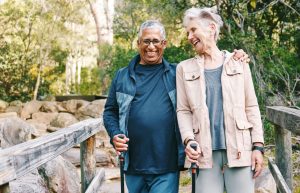People living in built-up areas find it harder to get active

Members of your generation struggled to develop long-term exercise habits if they spent their early adulthood living near industrial areas and in places dominated by social housing, compared to their peers living in suburbs, rural areas or by the seaside.
Researchers from UCL also found that people who experienced physical health and mental health difficulties in their 20s found it more challenging to keep active up to midlife.
What we asked you
In your early 20s and early 30s you answered a series of questions about your health and mental health.
At both age 33 and 50, you also told us how often you took part in leisure activities, such as swimming and going for walks.
We also added information about the neighbourhoods you’ve lived in from your census records to the data we hold about you.
What the research found
Overall, more than half of you (51%) said you kept active more than once a week in your early 30s and 50s. Only around a sixth of you (14%) said you exercised less than this.
Between your 30s and midlife, many of you changed your lifestyles. Almost a fifth of you became more active (18%), with a similar number reducing their level of weekly exercise (17%).
Neighbourhood and exercise
People in your generation who lived in urban neighbourhoods in their early 20s were less likely to be active up to midlife, compared to those living in suburbs, rural areas or by the seaside. They were also less likely to change their exercise habits for the better as they grew older.
More than a third of people (37%) in your generation lived in built-up neighbourhoods in early adulthood.
Health challenges
Members of your age group who were obese during their early 20s were less likely to be physically active in their 30s and 50s than their counterparts. They also tended to become less active as they reached midlife.
In addition, the research team discovered that those who had suffered illness and depression in their early 20s were less likely to exercise during adulthood.
Why this research matters
Previous research has shown that access to green spaces and leisure facilities can help people to be active in the short term. This important NCDS study reveals that where people live in early adulthood can help them form exercise habits that can persist into midlife.
The study’s authors noted that targeting investment in recreational facilities and public parks in urban neighbourhoods would help to increase physical activity across a substantial portion of the population, greatly improving both public health and wellbeing.
Read the full research report
Early adulthood determinants of mid-life leisure-time physical inactivity stability and change: Findings from a prospective birth cohort by Snehal M. Pinto Pereira and Chris Power was published in the Journal of Science and Medicine in Sport in July 2018.


 Back to news listing
Back to news listing 